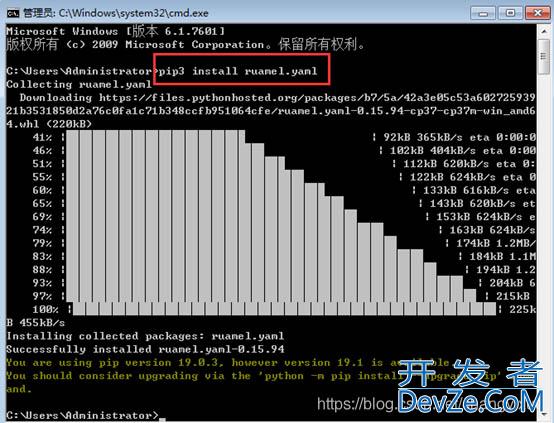如何用python脚本实现一次获取token,多次使用token
目录
- 1.两种格式的文件
- 2.编写鉴权文件testingedu_auth.py
- 3.编写获取token值的脚本:get_token.py
- 4.编写登录接口脚本
- 5.编写查看接口脚本
- 6.编写退出接口脚本
- 总结
1.两种格式的文件
1)编写配置文件Token.yaml(暂时为空),用来存放token值
另外:
用命令:pip3 install ruamel.yaml安装ruamel.yaml模块,用以去除yaml文件中的大括号

2)编写配置文件Access_token.yml,把token值写到配置文件中的关键代码如下:
# 把token值写到配置文件access_token.yml中
def write_token(res):
curPath = os.path.abspath(os.path.dirname(__file__))
yamlPath = os.path.abspath(os.path.dirname(curPath) + os.path.sep + "configs/access_token.yml")
# yamlPath = os.path.dirname(os.path.abspath('.'))+'/data/access_token.yml'
# res = json.loads(res)
tokenValue = {
'access_token': res["access_token"]
}
with open(yamlPath, 'w', encoding='utf-8') as f:
yaml.dump(tokenValue, f)
logger.info("\n token值已保存至配置文件中")
2.编写鉴权文件testingedu_auth.py
用于获取token值并存储token值:
#!/usr/bin/env python
# -*- coding:utf-8 -*-
# 用pip3命令安装
import requests
from ruamel import yaml
def test_testingedu_auth():
url = "http://www.XXX.com.cn/XXX/HTTP//auth"
headers = {"Content-Type": "application/json"}
# 发送请求
response = requests.post(url=url, headers=headers)
print(response.text)
print(response.编程客栈status_code)
print(response.json()["token"])
# return response.json()["token"]
# 把token值写入配置文件中
# cur = os.path.dirname(os.path.realpath(__file__))
# p = os.path.join(cur, 'Token.yaml')
yamlpath = r'C:\Users\Administrator\PycharmProjects\APITest\common\Token.yaml'
tokenValue = {
'token': response.json()["token"],
}
with open(yamlpath, "w", encoding="utf-8") as f:
yaml.dump(tokenValue, f, Dumper=yaml.RoundTripDumper)
if __name__ == "__main__":
test_testingedu_auth()
运行结果:

查看Token.yaml中的值:

3.编写获取token值的脚本:get_token.py
方便其他接口调用(登录、查看和退出)
#!/usr/bin/env python
# -*- coding:utf-8 -*-
import yaml
import os
# cur = os.path.dirname(os.path.realpath(__file__))
def get_token(yamlName = "Token.yaml"):
# 从配置文件中读取token值,并返回
p = os.path.join(r'C:\Users\Administrator\PycharmProjects编程客栈\APIjsTest\common\Token.yaml')
f =http://www.devze.com open(p)
a = f.read()
t = yaml.load(a)
f.close()
return t["token"]
if __name__ == "__main__":
get_token()
4.编写登录接口脚本
testingedu_login.py
#!/usr/bin/env python
# -*- coding:utf-8 -*-
import requests
from common.get_token import get_token
def testingedu_login():
url = "http://www.XXX.com.cn/XXX/HTTP//login?username=XXX&password=XXX"
headers = {"token": get_token()}
response = requests.post(url=url, headers=headers)
print("返回体是:", response.text)
print("状态码是:", response.status_code)
if __name__ == "__main__":
testingedu_login()
运行结果:

5.编写查看接口脚本
testingedu_info.py
#!/usr/bin/env python
# -*- coding:utf-8 -*
import requests
from common.get_token import get_token
def testingedu_info():
url = "http://www.XXX.com.cn/XXX/HTTP//getUserInfo?id=XXX"
headers = {"token": get_token()}
response = requests.post(url=url, headers=headers)
print(response.text)
print(response.status_code)
if __name__ == "__main__":
testingedu_info()
运行结果:

6.编写退出接口脚本
testingedu_logout.py
#!/usr/bin/env python
# -*- coding:utf-8 -*-
import requests
from common.get_token import get_token
def testingedu_logout():
url = "http://www.XXX.com.cn/XXX/HTTP//logout"
headers = {"token": get_token()}
response = requests.post(url=url, headers=headers)
print(response.text)android
print(response.status_code)
if __name__ == "__main__":
testingedu_logout()
运行结果:

总结
以上为个人经验,希望能给大家一个参考,也希望大家多多支持编程客栈(www.devze.com)。







 加载中,请稍侯......
加载中,请稍侯......
精彩评论